|
Have a safe day!
Friday, April 11
3:30 p.m.
DIRECTOR'S COFFEE BREAK - 2nd Flr X-Over
4 p.m.
Joint Experimental-Theoretical Physics Seminar - One West
Speaker: Abby Vieregg, University of Chicago
Title: Detection of B-mode Polarization on Degree Angular Scales with the BICEP2
Experiment at the South Pole
Saturday, April 12
7 p.m.
Pre-concert lecture
- One West
Speaker: Ralph Leighton
Title: Richard Feynman's Fantasy: The Marvelous Stamps of Tannu Tuva
8 p.m.
Fermilab Arts Series - Ramsey Auditorium
Huun-Huur-Tu: Throat Singers of Tuva
Tickets: $28/$14
Monday, April 14
THERE WILL BE NO PARTICLE ASTROPHYSICS SEMINAR THIS WEEK
3:30 p.m.
DIRECTOR'S COFFEE BREAK - 2nd Flr X-Over
4 p.m.
All Experimenters' Meeting - Curia II
Click here for NALCAL,
a weekly calendar with links to additional information.
Ongoing and upcoming conferences at Fermilab |
|
Friday, April 11
- Breakfast: blueberry-stuffed French toast
- Breakfast: chorizo and egg burrito
- Tuna melt
- Smart cuisine: white fish florentine
- Kielbasa and kraut
- Eggplant parmesan panino
- Cilantro lime chicken bowl
- Clam chowder
- Texas-style chili
- Assorted pizza by the slice
Wilson Hall Cafe menu
|
|
Friday, April 11
Dinner
- Mixed greens with dried cranberries, walnuts and blue cheese
- Veal limone
- Escarole and Tuscan beans
- Mixed berry pie
Wednesday, April 16
Lunch
- Pork satay with peanut sauce
- Jasmine rice
- Peapods
- Pineapple upside-down cake
Chez Leon menu
Call x3524 to make your reservation.
|
|
Edward Tufte's "Interplanetary Explorer" now installed for Feynman celebration
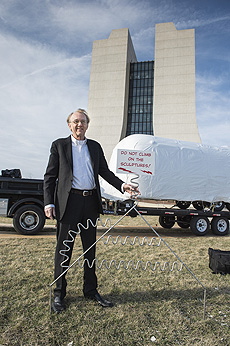 |
| Artist Edward Tufte's art installation "Interplanetary Explorer" was put into place in front of Wilson Hall on Thursday. It is one piece of his art exhibit at Fermilab. The exhibit opens tomorrow as part of the laboratory's Feynman celebration. Photo: Reidar Hahn
|
|
David Toback elected as new CDF co-spokesperson
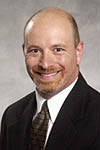 |
|
David Toback
|
The CDF collaboration elected David Toback as co-spokesperson on March 17. The Texas A&M physics professor will join fellow CDF spokesperson Costas Vellidis in leading the experiment.
Toback began working with the CDF collaboration in 1991, while he was a graduate student at the University of Chicago. But his CDF connection goes back even before his graduate work. Toback has known CDF physicists and mentors Henry Frisch and Mel Shochet since high school and graduated with Shochet's oldest son from the University of Chicago Laboratory High School.
"CDF has been good to me throughout my life and career," Toback said.
The CDF experiment is no longer collecting new data, so the role of the spokesperson has changed over time, Toback said. He wants to ensure that the group maintains a paper review process as strong as it has always been in the past, so CDF can continue to produce high-quality publications. The collaboration has a 400-person active author list.
"My primary goal is to help support authors so they can publish the important legacy papers," he said. "This includes measurements of the top mass, the W mass, the single top cross sections and the final word on the top forward-backward asymmetry."
Toback will replace outgoing co-spokesperson Luciano Ristori beginning June 1.
"I have huge shoes to fill — CDF owes him an enormous amount of gratitude," Toback said.
"Dave's enthusiasm and persistence are exactly what we need to make sure we
finish publishing all our final legacy results in a timely fashion," Ristori said.
Toback is currently the Thaman Professor as well as a member of the George P. and Cynthia Woods Mitchell Institute for Fundamental Physics and Astronomy at Texas A&M. On CDF, he serves as co-convener of the Top + Beyond the Standard Model Group. Toback led the team that built the timing system for the CDF electromagnetic calorimeter, an important upgrade for Tevatron Run II. He is the author of the textbook "Big Bang, Black Holes, No Math."
—Amanda Solliday
|
National Weather Service recognizes Fermilab
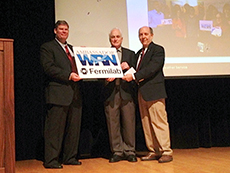 |
| Louis Uccellini (right), director of the National Weather Service, presents the Weather-Ready Nation Ambassador award to Mike Weis (left), DOE Fermi Site Office Manager, and Bill Flaherty (center), head of security at Fermilab and longtime organizer of the annual Severe Weather Seminar. Photo: Ed Fenelon, NWS Forecast Office, Romeoville, Ill. |
At the recent Tornado and Severe Weather Seminar, the National Weather Service presented Fermilab with the National Oceanic and Atmospheric Administration's Weather-Ready Nation Ambassador award.
Through the award, NOAA formally recognizes partners "who are improving the nation's readiness, responsiveness and overall resilience against extreme weather, water and climate events." Fermilab has hosted the local Tornado and Severe Weather Seminar for 34 years, partnering with WGN's Tom Skilling.
|
Heartbleed bug and Fermilab
There has been much publicity about the recently discovered Heartbleed bug in OpenSSL software. The bug is used to encrypt and protect sensitive information such as passwords and credit card numbers, during transmission across the Internet. Only certain versions and configurations of OpenSSL are vulnerable, and early reports describing the types of sensitive information that are exposed may be somewhat misleading.
In order to proactively address this issue, Fermilab has identified and addressed any of our systems (primarily Web servers) that were vulnerable. We have also been watching for and blocking any external attempts to use this bug to extract information from us. Moreover, the secure sites and services most commonly used by Fermilab users — FermiMail, SharePoint, Fermilab Time & Labor, ServiceNow and VPN — were never susceptible.
If you have concerns about your personal information being vulnerable at non-Fermilab websites, see
this list of which popular sites are affected. Be careful about changing passwords until you are informed that a site has been secured. And continue to be alert for spam email and phishing attempts to exploit people's nervousness about these recent events to obtain your passwords by more traditional means.
|
Latest CERN experiment confirms existence of exotic particle
From Interactions.org, April 10, 2014
Scientists at CERN's Large Hadron Collider (LHC) have confirmed the existence of a new class of subatomic particles, exotic hadrons.
A new measurement performed by the LHCb collaboration, one of the four large experiments at the LHC at CERN, has confirmed the existence of the exotic object labelled the Z(4430)-. This particle does not fit into the pattern of particles we have seen up to now. The LHCb result confirms an observation made by the Belle collaboration in 2008 that was later questioned and so resolves this previously unclear situation.
Read more
|
|
Top partners
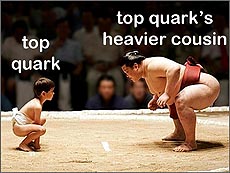 |
| Many extensions of the Standard Model predict that the top quark has a heavier partner. Together, these particles control unreasonable predictions of the mass of the Higgs boson made by the familiar Standard Model.
|
One consequence of quantum mechanics is that particles can change their identity, as long as they don't do it for very long. As an example, the recently discovered Higgs boson can temporarily morph into a top quark-antiquark pair before recombining into a Higgs boson. The particle is then free to turn into pairs of Z bosons, W bosons and (probably weirdest of all) Higgs bosons. This behavior has been established for all known subatomic particles. So far, so good.
While this frenzied morphing is common, the impact it has on something like the mass of the Higgs boson is less clear. It turns out that this behavior is predicted to drive the mass of the Higgs boson to values far, far, higher than have been measured. Since the measurement is quite precise, the mismatch between prediction and what is observed is perhaps the single most pressing question facing LHC physicists and almost guarantees that the LHC will discover something completely new. If it doesn't, it may be that the Standard Model of particle physics will need rethinking.
Given the incredible success of the Standard Model, it is theoretically popular to devise additions to the known theory that will tame the crazy predictions of quantum mechanics. Two of the most popular ones are to invoke supersymmetry and models in which the Higgs boson consists of smaller particles still. We need to remain open to all credible solutions.
In supersymmetry, known particles in the fermion family have undiscovered cousins in the boson family and vice versa. For instance, the fermionic top quark is predicted to have a bosonic stop squark. These two particles conspire together to cancel the huge mass of the Higgs boson predicted by the traditional Standard Model.
The idea that a Higgs boson is composed of other particles also predicts a partner of the fermionic top quark, but unlike a supersymmetric partner, it is also a fermion, not a boson. This model also says that the top quark, which has an electric charge of +2/3, has a partner with electric charge of +5/3. A particle with charge of +5/3 has never been observed, but such a particle is expected to decay in a striking way: The top partner would decay into a top quark and a W boson. Since these top partners would be produced in pairs, such an interaction would result in events with a top quark-antiquark pair and a W+W- pair.
CMS physicists have looked for events with these characteristics. No evidence for them was found. Researchers were able to establish that if these exotic top partners exist, they have a mass more than 800 times that of a proton. This limit is more than twice as large as the best previous measurement.
—Don Lincoln
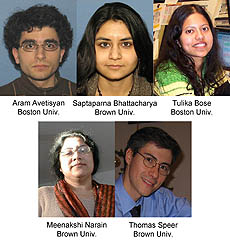 |
| These US CMS scientists contributed to this analysis.
|
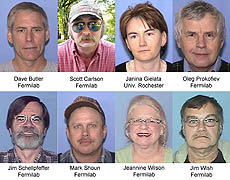 |
| The CMS detector has been running with a minimal muon detection system, which was nevertheless instrumental in the discovery of the Higgs boson. In order to increase redundancy in the future, additional detectors have been added to the existing cathode strip chamber system. The US CMS people pictured here have made important contributions in manufacturing these extra detectors.
|
|
Wilson Hall power outage - Saturday, April 19
Workers will perform electrical maintenance at the laboratory on Saturday, April 19. Wilson Hall will undergo a power outage that day from 6 a.m. to 6 p.m. The building will remain locked, and only authorized personnel will be allowed to enter the building.
|
Capturing a super energetic neutrino named Big Bird
From Wired, April 10, 2014
You're looking at a neutrino named Big Bird. This particle, which has an energy 1,000 times that of the protons smashed together at the LHC, traveled across the universe before hitting an atom at the South Pole and being recorded at an enormous underground observatory named IceCube.
Read more
|
|